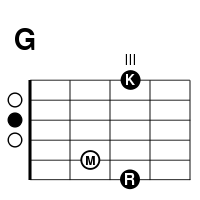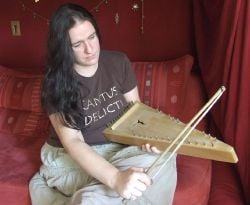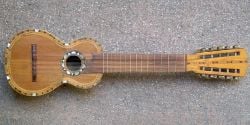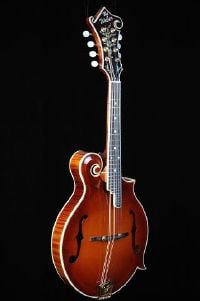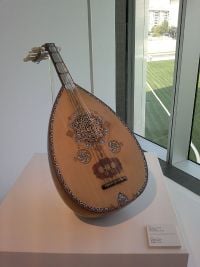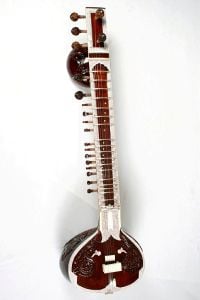String instrument
A string instrument (or stringed instrument) is a musical instrument that produces sound by means of vibrating strings, usually over a sounding board and/or resonating chamber. Plucking, bowing, and striking are the three most common techniques used in creating musical sounds from a stringed instrument. The length and tautness of the strings affect the pitch and tone of the sound produced. Strings are often shortened by using the finger or other device to "stop" the string and thus alter its pitch. Chords may be produced by playing more than one string at the same time.
In the modern orchestra, string instruments can be used as a solo instrument as well as being part of a larger section or entity. In the Hornbostel-Sachs scheme of musical instrument classification, used in organology, they are called chordophones. The most common string instruments in Western music are those in the violin, piano, and guitar families. String instruments are found in virtually every culture throughout the world, creating a wide variety of sounds and reflecting many types of musical traditions.
Acoustic string instruments

String instruments produce sound from one or more vibrating strings, transferred to the air by the body of the instrument or by a pickup device in the case of amplified instruments.
A vibrating string makes only a very quiet sound on its own. Thus string instruments are usually constructed in such a way that this sound is coupled to a hollow resonating chamber, a sounding board, or both. On the violin, for example, the taut strings pass over a bridge which rests on a hollow wooden box. The strings' vibrations are distributed via the bridge and sound-post to the surfaces of the instrument, and are thus made louder.
It is sometimes said that the sounding board or sound-box "amplifies" the sound of the strings. Technically speaking, no actually amplification occurs, because all of the energy to produce sound comes from the vibrating string. Instead, the sounding board of the instrument provides a larger surface area to create sound waves than that of the string. A larger vibrating surface moves more air, hence produces a louder sound.
Achieving a tonal characteristic that is effective and pleasing to the ear is an art, and the makers of string instruments often seek special woods to this end, particularly spruce (chosen for its lightness, strength and flexibility) and maple (a very hard wood). Spruce is used for the sounding boards of instruments from the violin to the piano.
In the early twentieth century, the Stroh violin used a diaphragm-type resonator and a metal horn to project the string sound, much like early mechanical gramophones. Its use declined beginning about 1920, as electronic amplification came into use. However, some string instruments still use resonators, such as in the Dobro steel guitar. Others achieve a wide variety of sounds by varying types of strings, design of the instrument's body, and materials, such as the drum-head used as a the sounding board of a banjo or metal used as the body of some guitars. Electronic amplification makes available a wide variety of other effects.
Means of sound production
Plucking
Instruments such as the guitar, oud, sitar and harp are plucked, either by a finger or thumb, or by some type of plectrum. This category includes the harpsichord, which formerly used feather quills (now plastic plectra) to pluck the strings. Strings in the violin category (violin, viola, cello, contrabass) are also plucked in various contexts, as defined by the Italian term pizzacato. A prime example of this is in the third movement of Tchaikovsky's Fourth Symphony, Opus 36, in which the entire movement is played with the pizzicato technique. Another style of pizzicato technique is known as the "Bartok pizzicato," named after twentieth century Hungarian composer Bela Bartok who designated in several of his scores to have a string plucked with such force as to have it snap against the instrument's fingerboard resulting in a loud percussive sound.
In the guitar, oud, and sitar group, plucking with the fingers is often called "finger picking" in which the player uses several fingers to play melodies or chords in an arpeggiated fashion. Classical guitar finger technique developed to the point where highly complex melodic, harmonic and contrapuntal music can be realized. The guitar works of twentieth century, Argentine composer Alberto Ginastera employ a wide variety of virtuoso finger techniques. Finger-picking is also common in the guitar traditions of American folk music, country music, jazz, blues, rock and roll and rhythm and blues. However, "flat-picking," using a plectrum or other device held between the thumb and one finger, is also prevalent.
Bowing
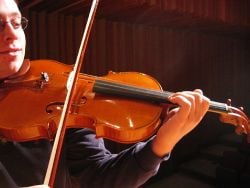
Bowed string instruments include the violin, viola, cello (of the violin family) and the double bass (of the viol family). The bow consists of a stick with many hairs stretched between its ends. Bowing the instrument's string causes a stick-slip phenomenon to occur, which makes the string vibrate.
Other bowed instruments are the nyckelharpa, kokyū, rebec, erhu, igil, kamanche, and sarangi. The hurdy gurdy is bowed by a wheel.
In the Western violin group, there are many types of bowing that yield a variety of sounds including, flautando (bowing near or over the fingerboard), sul ponticello (bowing near the bridge of the instrument), détaché (articulating notes in a separated fashion), martelé (a bow stroke with strong marcato attack), spiccato (a technique that employes an off-the-string bowing style resulting in a bouncing effect of the bow off the strings), jeté (a manner of bouncing the upper half of bow on the string yielding a series of rapid notes), louré (separating slurred notes slightly to articulate each note without stopping the bow), glissando (moving one's finger up and down a string to produce a indistinct sliding effect from pitch to pitch), tremelo (using small, rapid bow stokes with the upper part of the bow near the tip, usually on a single pitch), and col legno (using the wooded backside of the bow to strike the string).

Striking
The third common method of sound production in stringed instruments is to strike the string with a hammer. By far the most well-known instrument to use this method is the piano, where the hammers are controlled by a mechanical action. Another example is the hammered dulcimer, where the player holds the hammers. The piano is sometimes considered a percussion instrument, since sound production through struck blows defines this instrument family.
A variant of the hammering method is found in the clavichord: A brass tangent touches the string and presses it to a hard surface, inducing vibration. This method of sound production yields a soft sound. The maneuver can also be executed with a finger on plucked and bowed instruments; guitarists refer to this technique as "hammering-on."
Other methods and techniques
The aeolian harp employs an unusual method of sound production: the strings are excited by the movement of the air.
Some string instruments have keyboards attached which are manipulated by the player, meaning they do not have to play the strings directly. The most familiar example is the piano, where the keys control the felt hammers by means of a complex mechanical action. Other string instruments with a keyboard include the clavichord (where the strings are struck by tangents), and the harpsichord (where the strings are plucked by tiny plectra). With these keyboard instruments too, the strings are occasionally plucked or bowed by hand.
Other keyed string instruments, small enough to be held by a strolling player, include the plucked autoharp, the bowed nyckelharpa, and the hurdy gurdy, which is played by cranking a rosined wheel with the right hand while depressing keys with the left.
Steel-stringed instruments can be played using a magnetic field. An E-Bow is a small hand-held battery-powered device which can be used to excite the strings of an electric guitar. It provides a sustained, singing tone on the string which is magnetically-vibrated.
Vibrato, harmonics, and muting
Vibrato is an expressive device and is produced by using the left hand and wrist to slightly alter the length of the string resulting in a small change of intonation as the pitch oscillates slightly above and below the designated pitch. The use of continuous vibrato in Western orchestral performance practice is generally considered to be largely a twentieth century tradition. Historians point to the writing of Leopold Mozart (1719-1787) and Johann Joachim Quantz (1697-1773) to argue that vibrato was used sparingly in the music of the eighteenth and nineteenth centuries and usually as an expressive gesture or ornamental device.
Harmonics on string instruments are produced by lightly touching a string with a fingertip at the point on the fingerboard where a harmonic "node" exists. The result is the production of a higher pitch in the overtone series as well as a distinctly more transparent timbre.
In Western string playing, muting (con sordini) is the result of attaching a small rubber or wooden device to the bridge of the instrument which results in fewer overtones being audible and the realization of a hushed, mellow timbre. Muting in the guitar family is produced by damping the stings, usually with the palm of the right hand.
Contact points along the string
In bowed instruments, the bow is normally placed perpendicularly to the string, at a point half way between the end of the fingerboard and the bridge. However, different bow placements can be selected to change timbre. Application of the bow close to the bridge (known as sul ponticello) produces an intense, sometimes harsh sound, which acoustically emphasizes the upper harmonics. Bowing above the fingerboard (sul tasto) produces a purer tone with less overtone strength, emphasizing the fundamental, also known as flautando, since it sounds less reedy and more flute-like.
Similar timbral distinctions are also possible with plucked string instruments by selecting an appropriate plucking point, although the difference is perhaps more subtle.
In keyboard instruments, the contact point along the string (whether this be hammer, tangent, or plectrum) is a choice made by the instrument designer. Builders use a combination of experience and acoustic theory to establish the right set of contact points.
In harpsichords, often there are two sets of strings of equal length. These "choirs" usually differ in their plucking points. One choir has a "normal" plucking point, producing a canonical harpsichord sound; the other has a plucking point close to the bridge, producing a reedier "nasal" sound rich in upper harmonics.
Pitch
The length of the string from nut to bridge on bowed or plucked instruments ultimately determines the physical distance between different notes on the instrument. For example, a double bass with its low range needs a scale length of around 42 inches, while a violin scale is only about 13 inches. On the shorter scale of the violin, the left hand may easily reach a range of slightly more than two octaves without shifting position, while on the bass' longer scale, a single octave or a ninth is reachable in lower positions.
A string of a certain length and tension will only produce one note. To obtain additional notes, string instruments usually employ one of two methods. One is to add enough strings to cover the range of notes desired; the other is to allow the strings to be "stopped," or shortened. The piano is an example of the former method, where each note on the instrument has its own set of strings. On instruments with stoppable strings, such as the violin or guitar, the player can shorten the vibrating length of the string, using the fingers directly (or more rarely through some mechanical device, as in the hurdy gurdy or a bar as in the steel guitar). Such instruments usually have a fingerboard attached to the neck of the instrument, providing a hard flat surface against which the player can stop the strings. On many string instruments, the fingerboard has frets, raised ridges perpendicular to the strings that stop the string at precise intervals, in which case the fingerboard is called a fretboard.
Modern frets are typically specially shaped metal wire set into slots in the fretboard. Early frets were cords tied around the neck, still seen on some instruments as wraps of nylon mono-filament. Such frets are tied tightly enough that moving them during performance is impractical. The bridges of a koto, on the other hand, may be moved by the player, occasionally in the course of a single piece of music.
Producing stopped notes on the instruments of the Western string group or the guitar/oud group is a technique employed to produce chords by placing fingers on separate strings and bowing or plucking the strings simultaneously. These chords can consist of two, three or four pitches. In some cases melodies and chords can be produced simultaneously using stops. A prime example of this occurs in the second movement of Jean Sibelius' Violin Concerto.
Fingered string instruments (as opposed to the keyed variety) allow the playing of the same note on different strings, by stopping a lower string higher up the finger board. Thus Middle C may be played on the guitar by stopping the first fret of the B string, but it can also be played by stopping the fifth fret of the G string or the tenth fret of the D string. This allows for considerable flexibility in fingering technique as well as the creation of different tonal qualities in the notes or chords produced.
Some string instruments create pitch variations by the player bending the strings or otherwise adjusting their tensions. Guitar players, for example, often pull or push a string with the fingers of their left hand to create "blue notes" or to make a note slide upward or downward "into" a new note. In the pedal steel guitar and some banjos, similar effects are created with the use of mechanical pulleys or tuning pegs that temporarily re-tune the string by adjusting its tension.
The middle Eastern string instrument the qanun, though it has many strings to give a selection of notes, is equipped with small levers called mandal that allow each course of multiple strings to be incrementally re-tuned "on the fly" while the instrument is being played. These levers raise or lower the pitch of the string course by a microtone, less than a half step. Similar mechanisms which change pitch by standard intervals (half-steps) are used on many modern Western harps, either directly moved by fingers (on Celtic harps) or controlled by foot pedals (on orchestral harps).
Electronic amplification
Most string instruments can be fitted with piezoelectric or magnetic pickups to convert the string's vibrations into an electrical signal which is amplified and then converted back into sound by loudspeakers. Some players attach a pickup to their traditional string instrument to "electrify" it. Another option is to use a solid-bodied instrument, which reduces unwanted feedback howls or squeals. Amplified string instruments can be much louder than their acoustic counterparts, which allows them to be used in relatively loud rock, blues, and jazz ensembles. Amplified instruments can also have their amplified tone modified by using electronic effects such as distortion, reverb, or a wah-wah pedal, a device that electronically alters the pitch and sound of the strings.
Bass-register string instruments such as the double bass and the electric bass are amplified with bass instrument amplifiers that are designed to reproduce low-frequency sounds. To modify the tone of amplified bass instruments, a range of electronic bass effects are available, such as distortion and chorus.
The advent of electronic amplification greatly enhanced the role of string instruments, especially the guitar, in popular music. In recent decades, electric guitars have replaced previously louder instruments such as saxophones and trumpets as the lead voices in band music and have also been used frequently in the scores of movie and television soundtracks. They have also been incorporated by composers of contemporary symphonic music and operas.
Selected list of string instuments
Bowed instruments
- Ajaeng (Korea)
- Arpeggione
- Banhu (China)
- Bazantar (United States)
- Bowed psaltery
- Cello
- Cizhonghu (China)
- Crwth
- Dahu (China)
- Diyingehu (China)
- Double bass
- Erxian (China)
- Esraj (India)
- Fiddle (colloquial term for violin)
- Gadulka (Bulgaria)
- Ghaychak (Iran)
- Goje (Mali)
- Gudok (Russia)
- Haegeum (Korea)
- Hardanger fiddle (Norway)
- Jouhikko (Finland)
- Kemenche (Turkey)
- Kokyu (Japan)
- Masenqo (Ethiopia)
- Morin khuur (Mongolia)
- Nyckelharpa (Sweden)
- Octobass
- Psalmodikon
- Rebab
- Rebec
- Sarangi (Nepal, Pakistan and India)
- Sarinda (India)
- Saw sam sai (Thailand)
- Sihu (China)
- Trumpet marine or tromba marina
- Vielle
- Viol (viola da gamba)
- Lyra viol
- Violone
- Viola
- Viola d'amore
- Viola pomposa
- Violin
- Violotta
- Yaylı tanbur (Turkey)
- Yazheng (China)
- Yehu (China)
- Zhonghu (China)
Plucked instruments
- Appalachian dulcimer (United States)
- Autoharp (United States)
- Bağlama (Turkey)
- Bajo sexto (Mexico)
- Balalaika (Russia)
- Bandura (Ukraine)
- Bandurria (Spain)
- Banjo (American)
- Barbat (Iran)
- Begena (Ethiopia)
- Bordonua (Puerto Rico)
- Bouzouki (Greece)
- Bugarija (Croatia)
- Buzuq (Lebanon)
- Cavaquinho (Portugal and Brazil)
- Çeng (Turkey)
- Charango (Peru and Bolivia)
- Chitarra battente (Italy)
- Chitarrone (Mexico)
- Cittern (Britain)
- Cuatro (Puerto Rico)
- Cuatro (Venezuela)
- Cümbüş (Turkey)
- Đàn bầu (Vietnam)
- Đàn nguyệt (Vietnam)
- Diddley bow (United States)
- Dombra (Eastern Europe and Central Asia)
- Domra (Russia)
- Doshpuluur (Tuva)
- Dutar (Persia)
- Duxianqin (China)
- Ektara (India)
- Electric bass
- Electric upright bass
- Gayageum (Korea)
- Geomungo (Korea)
- Gottuvadhyam (India)
- Gravikord
- Guitar (Persia)
- Acoustic bass guitar
- Baritone guitar
- Cigar box guitar
- Electric guitar
- Harp guitar
- Resonator guitar (a.k.a. dobro)
- Seven-string guitar
- Tailed bridge guitar
- Tenor guitar
- Guitarrón (Mexico)
- Gusli (Russia)
- Guqin (China)
- Guzheng (China)
- Harp
- Electric harp
- Harpsichord (Europe, keyboard instrument)
- Irish bouzouki (Ireland)
- Kacapi
- Kantele (Finland)
- Kanun (Middle East, Persia)
- Kobza (Ukraine)
- Konghou (China)
- Kontigi (Nigeria)
- Kora (West Africa)
- Koto (Japan)
- Krar (Ethiopia)
- Kutiyapi (Philippines)
- Langeleik (Norway)
- Laud
- Liuqin (China)
- Lute (Europe)
- Archlute
- Theorbo
- Lyre
- Mandolin
- Mandola
- Octave mandola
- Mandocello
- Mando-banjo
- Mohan veena
- Monochord
- Musical bow
- Nyatiti (Kenya)
- Oud (Middle East, Greece)
- Pandura
- Pipa (China)
- Portuguese guitar (Portugal)
- Psaltery
- Qanún/kanun (Middle East, Persia)
- Qinqin (China)
- Ruan (China)
- Requinto
- Rote
- Rubab
- Rudra veena (India)
- Sallaneh (Iran)
- Sanxian (China)
- Saraswati veena (India)
- Šargija (Bosnia)
- Sarod (India)
- Saung (Burma)
- Saz (Turkey)
- Shamisen (Japan)
- Sitar (India, Pakistan)
- Tambura
- Tamburitza (Pannonian plain)
- Tanbur
- Tar (lute)
- Tea chest bass
- Tiple (Puerto Rico)
- Tiple (South America)
- Torban
- Tres (Cuba)
- Tricordia (Mexico)
- Ukulele (Hawaii)
- Valiha (Madagascar)
- Veena (India)
- Vichitra veena (India)
- Vihuela (Spain)
- Paul Panhuysen's string installations
- Yueqin (China)
- Zhongruan (China)
- Zhu (China)
- Zither
Struck instruments
- Berimbau (Brazil)
- Cimbalom (Hungary, Slovakia, Czech Republic, Romania)
- Chapman stick
- Chitarra battente, aka "knocking guitar" (Italy)
- Clavichord (keyboard instrument)
- Đàn tam thập lục (Vietnam)
- Hammered dulcimer
- Khim (Thailand and Cambodia)
- Piano (keyboard instrument)
- Santur/santoor (Persia, India, Pakistan, Greece)
- Warr guitar
- Yanggeum (Korea)
- Yangqin (China)
Instruments played in another way
- Aeolian harp (air movement)
- Hurdy gurdy (rotating wheel, similar in effect to a bow)
- Ellen Fullman's Long String Instrument, rubbed, the strings vibrate in the longitudinal mode
ReferencesISBN links support NWE through referral fees
- Jahnel, Franz. Manual of Guitar Technology: The History and Technology of Plucked String Instruments. Fachbuchreihe das Musikinstrument, Bd. 37. Frankfurt am Main: Verlag Das Musikinstrument, 1981. ISBN 9783920112718.
- Macauley, Anne. A Check-List of the Plucked and Hammered String Instruments in the Edinburgh University Collection of Historic Musical Instruments. Edinburgh: Reid School of Music, 1982. ISBN 9780907635031.
- Montagu, Jeremy. Origins and Development of Musical Instruments. Lanham, MD: The Scarecrow Press, 2007. ISBN 9780810856578.
- Remnant, Mary. English Bowed Instruments from Anglo-Saxon to Tudor Times. Oxford monographs on music. Oxford: Clarendon Press, 1986. ISBN 9780198161349.
- Robinson, Lisa Brooks. A Living Legacy: Historic Stringed Instruments at the Juilliard School. Pompton Plains, NJ: Amadeus Press, 2006. ISBN 9781574671469.
External links
All links retrieved February 26, 2023.
Credits
New World Encyclopedia writers and editors rewrote and completed the Wikipedia article in accordance with New World Encyclopedia standards. This article abides by terms of the Creative Commons CC-by-sa 3.0 License (CC-by-sa), which may be used and disseminated with proper attribution. Credit is due under the terms of this license that can reference both the New World Encyclopedia contributors and the selfless volunteer contributors of the Wikimedia Foundation. To cite this article click here for a list of acceptable citing formats.The history of earlier contributions by wikipedians is accessible to researchers here:
The history of this article since it was imported to New World Encyclopedia:
Note: Some restrictions may apply to use of individual images which are separately licensed.







